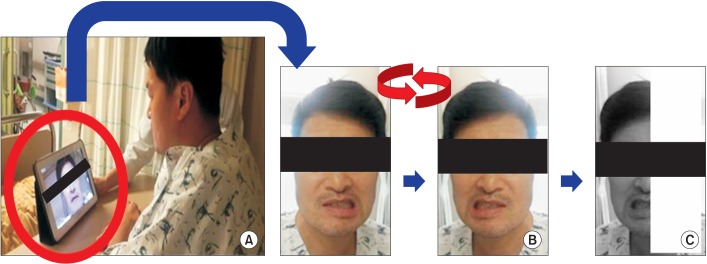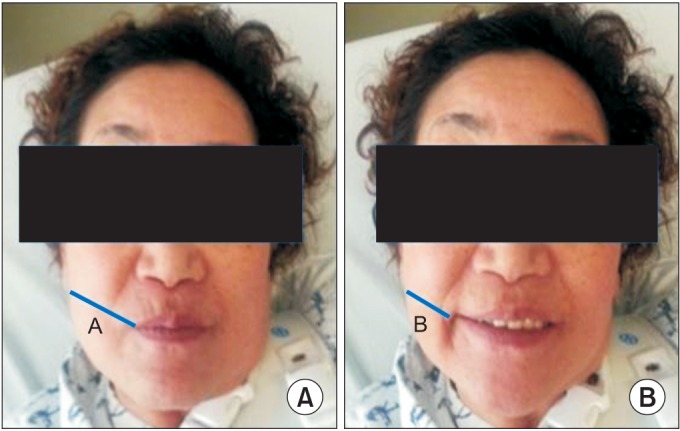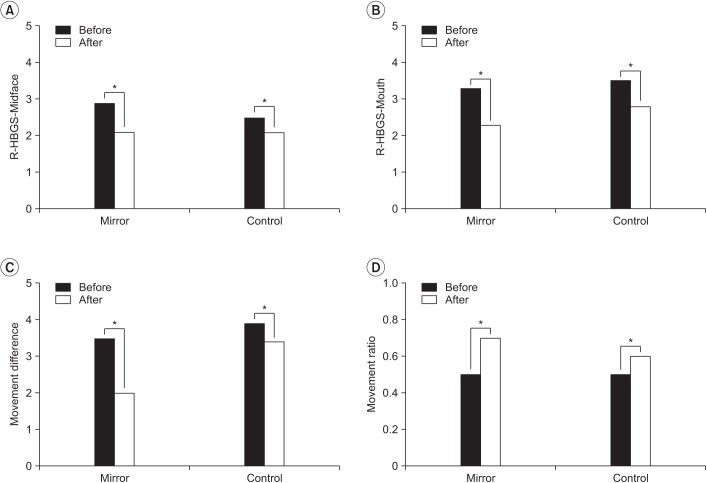Ann Rehabil Med.
2017 Jun;41(3):347-353. 10.5535/arm.2017.41.3.347.
Effects of Mirror Therapy Using a Tablet PC on Central Facial Paresis in Stroke Patients
- Affiliations
-
- 1Department of Rehabilitation Medicine, Asan Medical Center, University of Ulsan College of Medicine, Seoul, Korea. mhchun@amc.seoul.kr
- KMID: 2389449
- DOI: http://doi.org/10.5535/arm.2017.41.3.347
Abstract
OBJECTIVE
To investigate the effects of mirror therapy using a tablet PC for post-stroke central facial paresis.
METHODS
A prospective, randomized controlled study was performed. Twenty-one post-stroke patients were enrolled. All patients performed 15 minutes of orofacial exercise twice daily for 14 days. The mirror group (n=10) underwent mirror therapy using a tablet PC while exercising, whereas the control group (n=11) did not. All patients were evaluated using the Regional House-Brackmann Grading Scale (R-HBGS), and the length between the corner of the mouth and the ipsilateral earlobe during rest and smiling before and after therapy were measured bilaterally. We calculated facial movement by subtracting the smile length from resting length. Differences and ratios between bilateral sides of facial movement were evaluated as the final outcome measure.
RESULTS
Baseline characteristics were similar for the two groups. There were no differences in the scores for the basal Modified Barthel Index, the Korean version of Mini-Mental State Examination, National Institutes of Health Stroke Scale, R-HBGS, and bilateral differences and ratios of facial movements. The R-HBGS as well as the bilateral differences and ratios of facial movement showed significant improvement after therapy in both groups. The degree of improvement of facial movement was significantly larger in the mirror group than in the control group.
CONCLUSION
Mirror therapy using a tablet PC might be an effective tool for treating central facial paresis after stroke.
Keyword
MeSH Terms
Figure
Reference
-
1. Pavese C, Cecini M, Camerino N, De Silvestri A, Tinelli C, Bejor M, et al. Functional and social limitations after facial palsy: expanded and independent validation of the Italian version of the facial disability index. Phys Ther. 2014; 94:1327–1336. PMID: 24786937.
Article2. Konecny P, Elfmark M, Urbanek K. Facial paresis after stroke and its impact on patients’ facial movement and mental status. J Rehabil Med. 2011; 43:73–75. PMID: 21174055.
Article3. Dafer RM, Rao M, Shareef A, Sharma A. Poststroke depression. Top Stroke Rehabil. 2008; 15:13–21. PMID: 18250069.
Article4. Konecny P, Elfmark M, Horak S, Pastucha D, Krobot A, Urbanek K, et al. Central facial paresis and its impact on mimicry, psyche and quality of life in patients after stroke. Biomed Pap Med Fac Univ Palacky Olomouc Czech Repub. 2014; 158:133–137. PMID: 23558454.
Article5. Svensson BH, Christiansen LS, Jepsen E. Treatment of central facial nerve paralysis with electromyography biofeedback and taping of cheek: a controlled clinical trial. Ugeskr Laeger. 1992; 154:3593–3596. PMID: 1471279.6. Nakamura K, Toda N, Sakamaki K, Kashima K, Takeda N. Biofeedback rehabilitation for prevention of synkinesis after facial palsy. Otolaryngol Head Neck Surg. 2003; 128:539–543. PMID: 12707658.
Article7. Azuma T, Nakamura K, Takahashi M, Ohyama S, Toda N, Iwasaki H, et al. Mirror biofeedback rehabilitation after administration of single-dose botulinum toxin for treatment of facial synkinesis. Otolaryngol Head Neck Surg. 2012; 146:40–45. PMID: 21965443.
Article8. Rossiter HE, Borrelli MR, Borchert RJ, Bradbury D, Ward NS. Cortical mechanisms of mirror therapy after stroke. Neurorehabil Neural Repair. 2015; 29:444–452. PMID: 25326511.
Article9. Claflin ES, Krishnan C, Khot SP. Emerging treatments for motor rehabilitation after stroke. Neurohospitalist. 2015; 5:77–88. PMID: 25829989.
Article10. Thieme H, Mehrholz J, Pohl M, Behrens J, Dohle C. Mirror therapy for improving motor function after stroke. Cochrane Database Syst Rev. 2012; (3):CD008449. PMID: 22419334.
Article11. Reitzen SD, Babb JS, Lalwani AK. Significance and reliability of the House-Brackmann grading system for regional facial nerve function. Otolaryngol Head Neck Surg. 2009; 140:154–158. PMID: 19201280.
Article12. Selvaraj S, Stephen R, Paul P, Bright B, Sanjeev MP, Judy AD. Mirror therapy enhances motor performance in the paretic upper limb after stroke: a pilot randomized controlled trial. Arch Phys Med Rehabil. 2014; 95:2000–2005. PMID: 25064777.13. Kim H, Shim J. Investigation of the effects of mirror therapy on the upper extremity functions of stroke patients using the manual function test. J Phys Ther Sci. 2015; 27:227–229. PMID: 25642079.
Article14. Colomer C, NOe E, Llorens R. Mirror therapy in chronic stroke survivors with severely impaired upper limb function: a randomized controlled trial. Eur J Phys Rehabil Med. 2016; 52:271–278. PMID: 26923644.15. Sutbeyaz S, Yavuzer G, Sezer N, Koseoglu BF. Mirror therapy enhances lower-extremity motor recovery and motor functioning after stroke: a randomized controlled trial. Arch Phys Med Rehabil. 2007; 88:555–559. PMID: 17466722.16. Guo F, Xu Q, Abo Salem HM, Yao Y, Lou J, Huang X. The neuronal correlates of mirror therapy: a functional magnetic resonance imaging study on mirror-induced visual illusions of ankle movements. Brain Res. 2016; 1639:186–193. PMID: 26972531.
Article
- Full Text Links
- Actions
-
Cited
- CITED
-
- Close
- Share
- Similar articles
-
- Correction: Effects of Mirror Therapy Using a Tablet PC on Central Facial Paresis in Stroke Patients
- The Synergic Effects of Mirror Therapy and Neuromuscular Electrical Stimulation for Hand Function in Stroke Patients
- Effect of Mirror Therapy on the Balance, Gait and Motor Function in Patients with Subacute Stroke
- Efficacy of Mirror Therapy Containing Functional Tasks in Poststroke Patients
- Effects of Action Observation Training and Mirror Therapy on the Electroencephalograms of Stroke Patients




